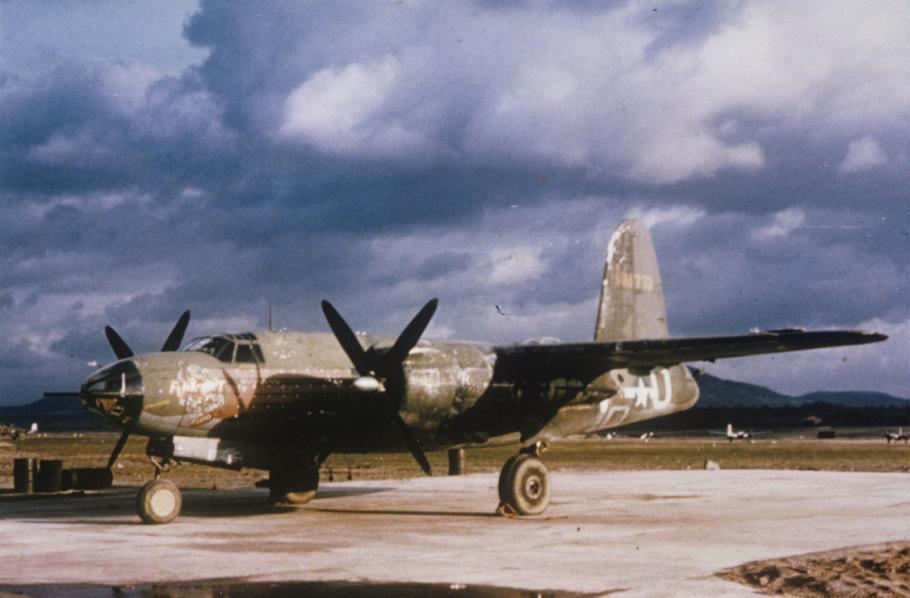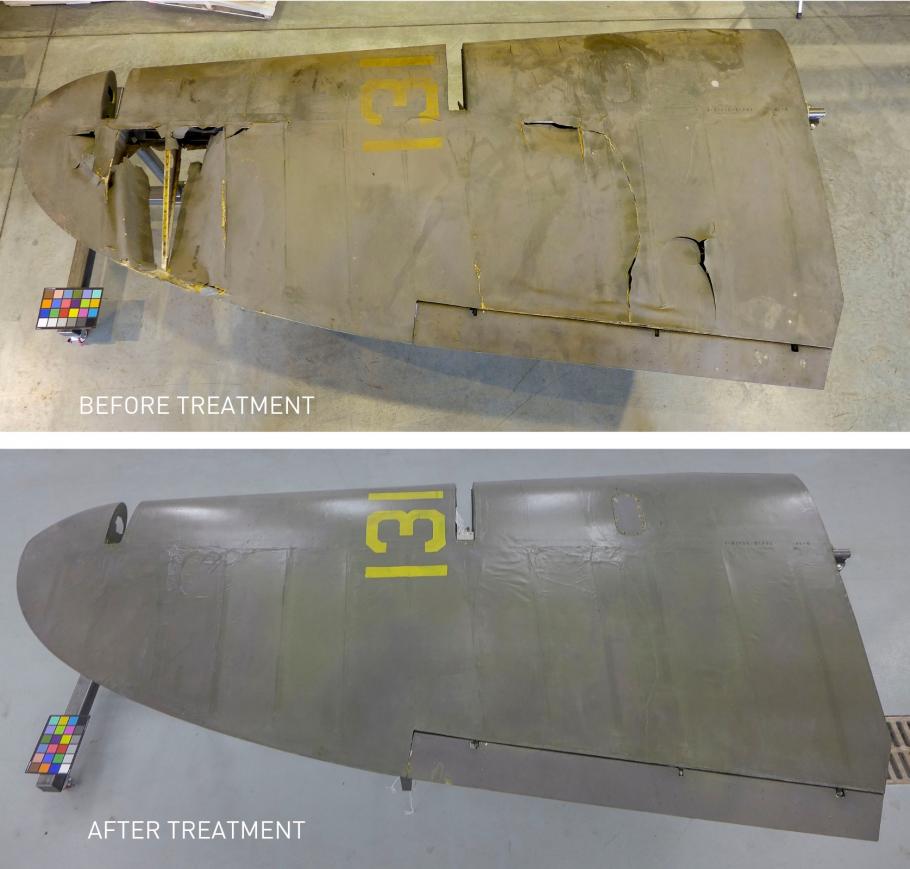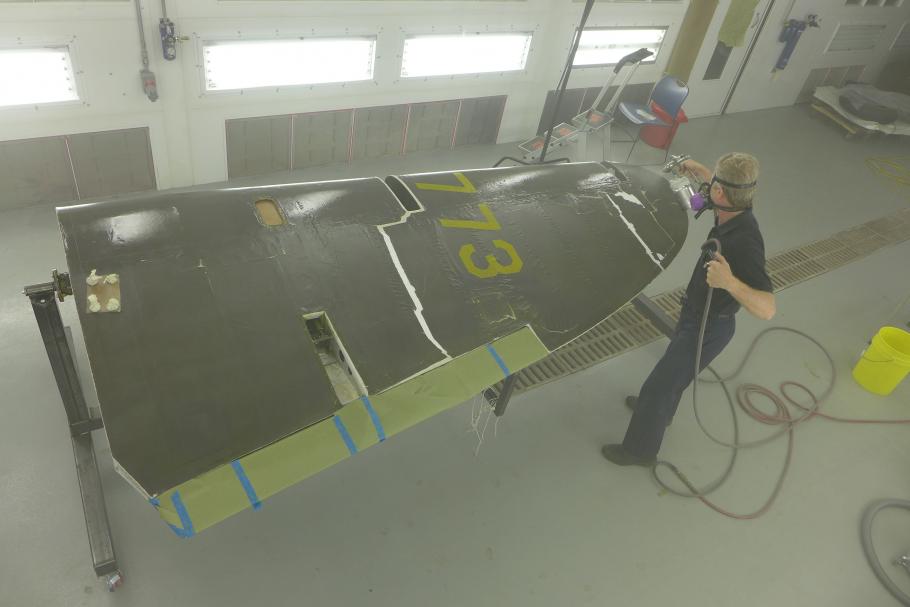The Martin B-26B Marauder Flak-Bait is an iconic artifact of World War II. This medium bomber and its crews survived over 200 missions over Europe, which was more than any other American combat aircraft in World War II. It is undergoing artifact treatment in the Museum’s Mary Baker Engen Restoration Hangar.
This photograph of Flak-Bait at the end of World War II documents a true survivor of the air war over Europe with chipped paint, battle damage repairs, and the general wear and tear of a combat airplane. Roger Freeman Collection (FRE 7083), Imperial War Museum.
Flak-Bait is remarkable for not only surviving the war but for surviving the subsequent 75 years in an amazing state of preservation. The Museum is currently working to ensure its state of preservation well into the future by performing a number of innovative conservation treatments.
A team of conservators and restoration specialists have developed new treatment techniques to retain original paint and fabric. This is the initial installment of a series of blogs on the treatment of Flak-Bait starting with the preservation of the doped fabric on the rudder.
Doped fabric is recognized as a material that has a limited life expectancy, traditionally made of cellulose-based resins such as cellulose acetate or nitrate. Dope is a waterproof and flexible coating over the cotton fabric on components such as rudders and ailerons. Cellulose-based resins have outstanding performance characteristics but they deteriorate relatively quickly. On operational aircraft, doped covered components needed to be recovered about every 10-12 years so it is remarkable that we still have the original doped components on Flak-Bait.
The components have deteriorated over time as expected, showing tears caused by shrinkage and losses caused by the embrittled material. Because these components bear the scars of operational use and damages caused during combat, we felt that it was imperative that these materials be preserved and retained on the aircraft. Conservation and restoration staff spent over a year on research and experiments to develop new methods to save the historic doped fabric.
Before and after treatment photos of Flak-Bait rudder.
How did we do it?
This process combines traditional aircraft restoration techniques with established methodologies found in paintings conservation. The process was recorded through both time-lapse video and digital photography, documenting our numerous treatment steps detailing how we arrived at the After Treatment image above.
The time-lapse video shows the initial stages of surface cleaning, applying a facing to the fabric to enable its safe removal from the structure, followed by corrosion reduction on the aluminum structure.
The photo below shows the internal structure once all the fabric was removed.
Next up is detailed cleaning and reduction of corrosion, tracked in the photo slideshow below.
Conservation and Restoration staff documenting combat damages and addressing areas of corrosion on the aluminum alloy structure.
The internal structure is then covered with Ceconite 102, a polyester fabric used to cover fabric-covered aircraft that are flying today. It does not shrink over time, making it an ideal foundation for remounting the original cotton fabric. In this image Conservator Lauren Gottshlich and volunteer Sharon Kullander are adhering the Ceconite to the structure.
Restoration specialist Anne McCombs in the process of heat-setting the Ceconite along the leading edge. She is assisted by Sharon Kullander and Duane Decker.
The rudder covered with heat shrunk Ceconite 102.
Custom Image Caption
While the rudder is being covered in Ceconite, the original doped fabric is surface cleaned and areas of curling fabric are relaxed and flattened. This photo shows the exterior surface of the doped fabric after curled areas have been relaxed and held in place with many small white adhesive backed strips.
A synthetic resin is applied to the Ceconite lining fabric and to the inner surface of the doped fabric. Watch the process in the next time-lapse video.
Step two of the process of preserving the doped fabric on the rudder of the Museum's Martin B-26B Marauder Flak-Bait.
Once the synthetic resin has been built up to the appropriate thickness, the doped fabric is placed back onto the lining fabric and structure, then heat-set into place. This forms a strong but reversible bond.
The fabric once it is re-attached to the Ceconite.
The white areas that you see above are from tears and pre-existing losses in the doped fabric. These areas were filled with a synthetic filler. The fill material has to have the same texture and level as the original fabric and is worked until it perfectly matches the shape of the loss. This process takes a lot of patience and constant adjustments as you will see in the last segment of the time-lapse video.
Step one of the process of preserving the doped fabric on the rudder of the Museum's Martin B-26B Marauder Flak-Bait.
Once the fill material stage is completed, we coat the surface with a clear protective layer that helps to saturate the oxidized doped fabric to bring out its original color.
Restoration specialist Dave Wilson applying the first protective layer of varnish on the doped fabric.
The rudder after the first layer of protective coating and prior to in-painting areas of white.
Once the protective layer is applied, we in-paint only the areas of white that you see in the image. This process involves color matching to the areas surrounding the white so that the surface appears seamless when we are done. The results of the in-painting can be seen below. Once we are done with the in-painting, we give the surface one final coat with a matting agent to reduce the gloss to simulate its original appearance.
After in-painting and applying the final top layer of protective coating.
Through this process, we have ensured that Flak-Bait will continue to be regarded as a truly unique and incredibly authentic survivor from WWII. This groundbreaking and pioneering process is much more involved than we can discuss in this short blog, but it represents the level of commitment that NASM staff have towards ensuring the preservation of our nation’s aerospace heritage.
Besides the Aeronautics and Collections departments, many of our colleagues not necessarily involved in artifact treatment contributed in many ways, including Adam Bradshaw and Glenn Rankin in Exhibits Production, as well as David Adcock and Jon Boyette in Special Events for lending the time-lapse cameras and editing the film. We are also very grateful for the work of the Engen Conservation Fellows.
Lauren Horelick is the objects conservator for Flak-Bait
Jeremy R. Kinney is the curator for Flak-Bait
*All conservation images courtesy Lauren Horelick



